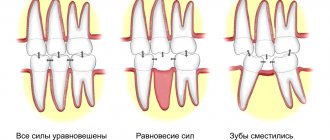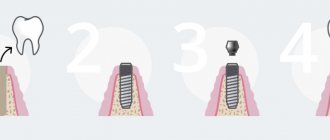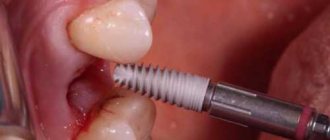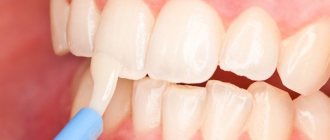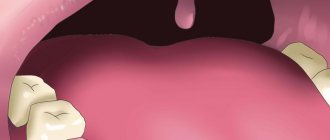Modern dentistry always focuses on avoiding, if possible, surgical intervention and preserving the patient’s natural tooth. One way or another, natural teeth form the correct bite and look quite aesthetically pleasing and harmonious. Unfortunately, it is not always possible to complete the task. Various pathological processes that affect not only the crown of the tooth or its roots, but also the underlying tissues, including bone, often require total tooth extraction using surgical methods. In this case, many patients are concerned about the question of when to perform prosthetics of an extracted tooth
.
Some are in no hurry to complete this task, citing one reason or another, but it is worth noting that prosthetics must be performed, first of all, in accordance with the recommendations of the attending physician, who will take into account all factors and advise methods for performing this procedure. This is due both to the anatomy and physiology of occlusion in general, and to the individual characteristics of the patient. Untimely prosthetics can lead to such consequences as:
- aesthetic problems;
- changes in facial features and shape;
- disturbances in the work and functioning of the maxillofacial joint;
- bonding or movement of teeth;
- destruction of healthy teeth;
- digestive problems and more.
After tooth extraction, prosthetics on time
, recommended by your dentist, will help you avoid these and many other problems and keep your teeth.
What can be put in place of an extracted tooth?
There are many options for replacing an extracted tooth. An experienced orthopedic surgeon will offer removable and fixed structures, solutions for restoring individual teeth or a number of missing units, and reconstruction of a completely edentulous jaw. For each case, protocols, methods, and treatment techniques are provided.
How to insert a tooth in place of a removed one - options:
- prosthetics on dental implants;
- bridge prosthesis;
- removable prosthetics;
- clasp prosthesis.
What can be put in place of an extracted tooth depends on:
- number of units removed;
- condition of bone tissue;
- dental diagnoses;
- patient's age.
Based on the preliminary diagnosis, the doctor makes a decision on the timing and features of treatment.
Which dentistry can I order temporary dentures from?
When choosing a clinic, you need to pay attention to its reputation, it is worth taking reviews into account, but the determining criterion for most people is cost. Our dental clinic “Tri Dental” offers a list of services and privileges:
- The experience of doctors and the availability of special equipment allows you to install removable and fixed temporary teeth after extraction at an affordable price;
- short production time (up to 2 days), but it all depends on the complexity of the prosthetics;
- high quality - we use only certified materials that meet sanitary requirements;
- long service life - in most cases, temporary teeth after removal are not worn for more than 6 months, but under certain circumstances the period can be increased several times without harm to health;
- services are provided under a contract, and all procedures are guaranteed!
If you have any questions, you can always contact our specialists for advice by phone.
How long does it take for gums to heal after tooth extraction for dental prosthetics?
How many days after extraction you can insert teeth determines the speed of healing of the hole. The process is individual for everyone and depends on many factors:
- type of removed unit - incisor, canine, molar, premolar;
- complexity of the operation - simple extraction or removal with dissection of the gums and sawing of the crown;
- features of the root system - compact, even roots or sinuous, strongly curved, occupying a large area;
- The doctor’s professionalism and experience determines the size of the extracted tooth socket and the likelihood of complications.
How long after tooth extraction can you get dentures?
How long after tooth extraction you can get dentures depends on the speed of tissue healing. Average indicators of restoration of gums and bone structures:
- the first 2 hours after removal - the hole fills with blood, a blood clot forms;
- a week after surgery - the wound heals, new gum tissue forms;
- after 4-6 months, the bone tissue is restored, completely filling the space of the socket.
For removable and fixed dentures, crowns on implants and bridges, different treatment periods are provided:
- removable dentures - in 3-7 days, how will it be possible to make an impression for the manufacture of a prosthetic structure;
- bridges - in a month or two, after complete healing of the tissues;
- prosthesis on implants - depending on the protocol, immediately or after a few months.
If the patient immediately plans to insert a tooth in place of the extracted one, it is better to make an appointment with an implant surgeon. The doctor will prepare directions for mandatory examinations, conduct careful removal, and offer optimal options for restoring the dentition.
"Butterfly"
A removable microprosthesis “butterfly” comes to the rescue when 1-2 teeth are missing. The technique is used to eliminate defects in the frontal area. Its advantages:
- speed - 1-2 visits to the orthodontist;
- no need to grind adjacent teeth;
- high aesthetics;
- low price.
The “butterfly” can be made of metal ceramics, entirely of plastic on a cast frame, or with a metal wire fastening. The technique is not used to restore the dentition on the lateral areas of the jaw, which experience significant stress when chewing food.
The process of prosthetics begins with diagnosing the condition of the teeth, cleaning them from tartar, filling and removing teeth, treating gums and other measures. The period from the time of tooth extraction to the installation of a bridge, clasp or plate prosthesis is from 1 day to 1-2 months.
The technique of one-stage prosthetics is used for:
- absence of inflammatory processes and infections in the oral cavity;
- good condition of gums, teeth, bone tissue.
The general physiological condition of the patient is taken into account.
According to statistics, installation of removable dentures in place of extracted teeth is possible in 1-4 weeks.
It may take from several hours to several weeks to get used to. Not only the skill of the specialist, but also the psychological mood of the patient is of great importance. Pain may not appear immediately. Correction can be carried out no earlier than the next day, provided that the structure is in the mouth for at least 4 hours. Several adjustments may be needed.
In the first days, a speech defect is usually observed, its severity is determined by the degree of bulkiness of the structure. Patience and regular exercise will help you get rid of it in 1-3 days.
The service life of removable dentures is 5-10 years, determined by the condition of the gums and teeth (for clasp dentures).
Caring for removable dentures is similar to caring for living teeth - brushing and rinsing. Removable dentures should always be kept in a damp environment. Using a fixing cream or gel will ensure a tight fit of the structure to the gum and prevent food debris from getting under the denture. For disinfection, special antiseptic agents are used, available in the pharmacy chain.
Even if your teeth are completely missing, regular visits to the dental office are recommended to monitor the condition of the oral mucosa. If there are no problems, you should visit an orthopedic dentist at least once a year. The specialist will assess the condition of the structure and, if necessary, make corrections.
Bridge prosthesis in place of an extracted tooth
The design of a dental bridge consists of the main crowns for replacing missing units and two additional ones for fixing the prosthesis on the jaw. During the treatment process, the doctor grinds down the living teeth and attaches crown caps to them. Advantages of a dental bridge for the patient:
- durable permanent installation;
- affordable price;
- aesthetics.
Flaws:
- Delayed prosthetics. The minimum period when a bridge can be installed after tooth extraction is a month after the operation.
- Grinding healthy units. Physical damage to the integrity of the enamel and partially crowns.
- Excessive load on supporting teeth. And degradation of bone tissue under the overhanging part of the denture.
- Gradual loss of aesthetics and functionality. Due to tissue subsidence, a gap is formed between the denture and the gum, visible when speaking. Also, food particles get into the empty space, which often causes inflammation.
- Fragility. The prosthesis and supporting teeth are usually removed 5-7 years after installation.
Doctors explain not only how long after tooth extraction a bridge can be installed, but also why. 4-8 weeks is a reasonable interval, since the tissue at the site of the lost tooth should be completely restored. Otherwise, there is a risk of changing the shape of the gums under the installed prosthesis, and the likelihood of tissue injury at the time of prosthetics increases.
Fixed dentures
Fixed dentures are rigidly fixed in the oral cavity with cement compounds. They are designed to restore various defects of teeth and dentition. This:
- crowns;
- bridge structures.
Single crowns can restore the anatomical shape of a damaged tooth with preserved stability and root structure. They are made of metals, plastics, ceramics, as well as metal-plastic and metal-ceramics.
Bridge structures are bridges that completely cover the area with missing teeth. The pontic consists of artificial teeth, and the supports are made of crowns that are attached to strong teeth. When chewing food, pressure is evenly distributed throughout the dentition. Bridge structures can be solid metal or combined - metal and plastic, metal and ceramics.
Installation of fixed dentures can be carried out over several visits: grinding of the supporting teeth and making an impression, fitting of the prosthesis, correction of the structure and its fixation.
After tooth extraction, fixed dentures can be installed immediately after the wound has healed - 7-10 days. If the period of preparation for prosthetics takes a long time, the patient is made of temporary dentures for the front part of the dentition.
The less time has passed since the damage/loss of the tooth, the shorter the adaptation period.
The durability and reliability of removable dentures are determined by the general health of the patient and proper care.
Caring for removable structures consists of carrying out the usual activities: brushing your teeth with toothpaste, rinsing your mouth with special compounds. The use of dental floss is not recommended, as there is a risk of damaging the denture attachment. Regular visits to the dentist's office for diagnostic, preventive and therapeutic measures will help preserve the remaining teeth and extend the life of fixed dentures.
Removable prosthetics
A removable denture is recommended when several units are removed or when the entire jaw is missing. For a single replacement, doctors recommend a temporary option - an immediate prosthesis, which is placed in place of the removed incisor or canine to preserve aesthetics. Then the product is replaced with a permanent and more convenient to wear option.
For removable prosthetics of one tooth, a high-quality impression of the jaw is required, which is made 3-4 days after the extraction operation. To make extended structures for several teeth, doctors recommend waiting until the tissue is completely restored. It takes about 30 days for the gums to heal before prosthetics.
Questions and answers
— What to do if swelling occurs after tooth extraction and implantation?
Swelling is a normal reaction after any implantation protocol, because... This is a surgical type operation. The dentists of our clinic always provide consultations and give instructions to patients on how to act before surgery.
— Differences between immediate and delayed implantation (Briefly)
| One-step | Deferred | |
| Restoring aesthetics in 1 day | The implant can be loaded with a temporary crown, which is removed from the bite. | The only way to restore the beauty of a smile is to attach a removable denture to the adjacent teeth. |
| Jaw bone resorption | Doesn't happen, because the implant is installed immediately. | Does not occur if implantation is carried out within six months after the removal of a dental unit. |
| Restoring bone volume | Not required or can be performed simultaneously with implant installation | If the atrophy process has already begun in the bone, an osteoplasty procedure will be needed before restoring the teeth. |
| Formation of the gingival margin | Required before installing a temporary crown | Performed before installation of an orthopedic prosthesis |
| Cost of services | Acceptable | In the future, higher than one-stage (due to the need for more procedures) |
— Is it possible to implant an artificial root after tooth and cyst removal?
A cyst is a new formation that can reach a diameter of 0.9 to 3 cm. It is usually located at the very edge of the tooth root. In most cases, the formation can be cured with medication.
But in later stages, the cyst can lead to loosening of the root. At the same time, the periodontal tissues are in an inflamed state, which makes it impossible to carry out immediate implantation (the risk of rejection increases to almost 100%).
Experienced dentists recommend waiting for complete recovery and installing the implant using a delayed protocol.
— Why is implantation called the best method of restoring teeth? (Comparison with alternatives)
Installation of a dental bridge.
Involves preparation (grinding) of adjacent units. A bridge is secured to these teeth, covering the gap. Used when 1 to 4 teeth are missing.
How is implantation different?
In case of implantation, it is possible to restore one, several in a row (or several scattered ones), as well as all teeth in the jaw. No turning of adjacent units is required.
Removable prosthesis.
It is used when most or all teeth in the jaw are missing. Can be attached to remaining teeth using special hooks. With complete edentia (the absence of all teeth), the prosthesis is held in place by adhesion forces and may fall out. Also, the removable orthopedic design does not prevent jaw bone resorption, which requires relining the prosthesis every 5 years.
What are the advantages of implants?
They prevent the development of bone tissue atrophy due to the fact that they evenly distribute the load across the entire jaw. The structure cannot fall out.
| Expert, author of the article: Akhtanin Evgeniy Alexandrovich Dental surgeon, implantologist 13 years of implantation experience Material updated: October 11, 2022 |
Crown instead of an extracted tooth - implantation
Implantation is a modern solution for partial and complete adentia. This is what doctors recommend to patients, and there are many reasons for this:
- complete replacement of a lost tooth - not only the upper part, but also the root system;
- restoration of chewing and other functions - after prosthetics, the patient is not limited in the choice of menu, and the quality of speech does not suffer;
- aesthetics - both the crown itself and the artificial gum contour, if present, look natural;
- preservation of bone tissue - bones experience full load, which eliminates atrophy and degradation of bone structures;
- speed of prosthetics - some protocols allow you to restore a tooth immediately after removal.
Implantation options:
- Classic two-step protocol. After removal, the doctor waits for complete healing of the gums and restoration of soft and bone tissues. Then he installs the implant and, after its complete engraftment (4-6 months), places an artificial crown or bridge on the implants without damaging neighboring units. The treatment is long and is recommended for patients who, immediately after extraction, were unable to replace their teeth with prosthetics - the socket has healed, and the tissues have partially atrophied. It is possible to speed up treatment using a two-stage protocol. Premium dental implants Nobel, Strauman take root in 2-4 months, which reduces the period of prosthetics by half.
- One-stage implantation protocol. When a tooth is removed, the patient is immediately implanted with an implant, a gum former or a full-fledged temporary crown. Such treatment requires removal by an experienced implant surgeon, as well as preliminary examination to reduce risks.
- One-stage implantation protocol. It completely eliminates the question of when a tooth can be replaced with a prosthetic after extraction, as it combines all three stages of treatment. The doctor performs an extraction, places a dental implant and immediately loads it with a crown. The patient simply replaces the damaged tooth with a new artificial one, which significantly speeds up the recovery process.
Basic techniques
Restoring integrity is the task of prosthetic dentistry, within which a variety of solutions are offered. Each method differs in both the duration of the prosthetic cycle and the functional and cost characteristics of the structures created.
Temporary dentures
To create artificial crowns, bridge-type prostheses or removable structures, as a rule, it takes from 2-3 weeks to several months. This duration is determined by the requirements for accuracy, aesthetics, strength and other parameters of the replacement product, which must fully replace the lost tooth. However, in situations where a gap has formed in the frontal area and is noticeable when communicating with others, not every patient is ready to withstand a long wait. The solution to the problem is the installation of a temporary prosthesis intended for short-term use.
Such products are used both in the manufacture of permanent structures and during the period of osseointegration of implants, or during preliminary preparation for orthopedic restoration. Temporary prostheses include:
- Removable structures are the so-called “frogs” and “butterflies”, which are a single artificial crown with nylon retainers, due to which it is attached to units adjacent to the edentulous area. Such models are produced quickly - within one clinic visit;
- Fixed structures are polymer products that allow you to close a gap in one or more teeth, used when planning the installation of artificial crowns made of metal ceramics or zirconium dioxide.
Temporary dentures perform a predominantly aesthetic function, restoring the integrity of the dentition and preventing the displacement of individual units, but do not participate in the distribution of chewing load. In this regard, prolonged wearing of replacement products made of polymers, even if they provide an attractive smile, is not recommended, since over time the structure will not only lose its aesthetics, but will also begin to deteriorate in the oral cavity.
Permanent dentures
Prosthetic structures installed on a permanent basis are designed for a long service life. However, whether the system will be able to withstand the declared load is a circumstance that depends on many factors.
The most common types of permanent dentures include:
- Bridge structures. Used for the restoration of several missing teeth located sequentially. As a support, preserved natural units are used, which are subjected to preparation and, as a rule, depulpation. The material used for manufacturing is metal-ceramics or zirconium dioxide, depending on the medical indications and financial capabilities of the patient.
- Plate dentures. Systems that combine an artificial base that imitates gum tissue and artificial crowns that restore the dentition in certain areas of the jaw. The acrylic or polyamide structure provides for the presence of clamps, locks or other fastenings. Such prostheses are cheaper, but require a long time to get used to, and do not exclude the development of tissue atrophy.
- Clasp models. The design is similar to the previous option, the difference being a pre-installed arc made of medical steel. The clasp ensures the distribution of the chewing load on the jaw area, and allows you to wear the system around the clock - without additional care and special procedures.
Total prosthetics after tooth extraction
The situation is considered separately - the removal of all teeth immediately before prosthetics. In this case, the patient is faced with complete adentia, which requires emergency treatment.
Option two:
- Removable prosthetics - quickly, inexpensively, with guaranteed atrophy of bone tissue subsequently, frequent replacement of the prosthesis and inconvenience of wearing the product.
- Implantation with installation of a fixed prosthesis - according to all-on-4 or all-on-6 protocols. The essence of the treatment is the installation of a fixed number of dental implants and the attachment of a full denture prosthesis to them. Implantation of 4 or 6 artificial roots is performed on the day of removal. An impression is immediately made, from which artificial teeth are made in a dental laboratory. The longest waiting period is 3 days, after which the patient receives a full-fledged jaw capable of withstanding all physiological loads.
When is immediate implantation possible immediately after removal?
The rate of loss of the alveolar ridge depends on the person’s health, bone structure and density. This is an individual parameter that is difficult to calculate in advance. Therefore, immediate installation of a titanium rod in place of the extracted tooth is preferable. This protocol excludes bone atrophy.
The survival rate of artificial roots installed in the early period after extraction of units is 99.6%. The risk of complications and implant rejection is minimal.
However, not all patients can have an implant installed at once.
To perform the operation, the following conditions are required:
- atraumatic removal of one's own unit;
- tight fit of the gums in the area of manipulation;
- small hole diameter;
- absence of inflammatory changes in bones and gums;
- sufficient volume and density of the alveolar ridge.
At the removal planning stage, the doctor conducts an examination, which includes a computed tomography scan. Based on the results of the study, the location of the unit, bone density and volume are assessed. A repeat scan is performed after removal. By studying the images, the doctor assesses the diameter of the hole and then determines whether an implant can be placed. If possible, forms a bed and installs an artificial root. The adjacent areas are filled with osteoplastic material. Next, the doctor installs a crown or sutures soft tissue until the implant is completely osseointegrated.
Contraindications for the one-stage protocol
- Traumatic tooth extraction;
- extraction for a cyst at the root apex;
- purulent complications of caries;
- inflammation of soft tissues;
- poor oral hygiene.
Advantages
- High implant survival rate;
- rapid osseointegration of titanium rods;
- minimum of injuries during installation;
- low risk of complications;
- reducing the number of surgical interventions;
- the ability to instantly restore the aesthetics of a smile.
Flaws
- There are contraindications;
- it is necessary to strictly follow the doctor’s recommendations during the rehabilitation period.
Is it necessary to insert a tooth after extraction?
Many patients do not even ask questions about how many days after tooth extraction they can get a crown or dentures. But in vain. Even a short-term absence of a tooth in the jaw row is fraught with serious consequences:
- displacement of adjacent units and teeth of the opposite jaw towards the empty space;
- jaw deformation, malocclusion;
- improper redistribution of chewing loads, gastrointestinal problems;
- deterioration of diction, the appearance of complexes due to aesthetics and speech.
The longer the interval between removal and prosthetics, the more serious the orthodontic defects and the more expensive the treatment.
Implantation in the period from 2 months to six months
Delayed implantation within 3-6 months
implies complete healing of the alveoli after removal of a dental unit.
This protocol has a long history of clinically documented testing and is therefore used in many dental clinics.
Indications
to this protocol:
How long can it take to get an implant if a tooth has been removed?
Until recently, it was believed that implantation immediately after extraction was risky. The higher level of modern dentistry allows immediate installation of artificial roots without any problems. Despite this, one-stage implantation is used less frequently compared to the classic two-stage method.
Possible installation times:
Simultaneously with tooth extraction - depends on the condition of the oral cavity, the doctor’s experience and the implant model. The extraction should proceed without complications, and the hole should be within acceptable dimensions. The presence of these conditions can only be known after removal.
- Advantages: the bone does not atrophy.
- Disadvantages: relatively higher risk of complications.
- Features: lack of complete sanitation of the oral cavity, the necessary studies have not been carried out.
After 3-5 months , when the jawbone is completely restored. The optimal period, since the bone manages to reach the required density, becomes ready for implantation of an artificial root.
- Advantages: the oral cavity is thoroughly prepared for surgery, which reduces the risk of postoperative complications.
- Disadvantages: The patient must wait for some time.
- Features: availability of all necessary test results and research.
In a longer period - if the tooth was removed a long time ago and prosthetics were not performed.
- Advantages: complete restoration of the functions of the dentofacial apparatus.
- Disadvantages: possible development of atrophy of the jaw bone (the severity of the pathology depends on the time during which the tooth was missing).
- Features: Bone grafting required.
Opinion of a maxillofacial surgeon : “It is impossible to delay installing an implant in an empty space, since without proper load the bone will quickly atrophy. It is better to carry out implantation 2-3 months after extraction. During this time, bone and soft tissues heal completely.
Nowadays, express methods are often used, when a titanium root is placed directly into the socket of an extracted tooth. This allows us to avoid bone grafting, however, to implement the procedure, all conditions must be met, which is not always possible.”
- Complete restoration of the dentition in just 4 days!
more detailsRoott Pterygoid Implants Sinus lift is no longer needed!
more details
Once and for life! Express implantation in 4 days with a permanent ReSmile prosthesis
more details
All-on-4, All-on-6, ReSmile, Zygomatic implantation We use all modern methods of dentition restoration
more details





